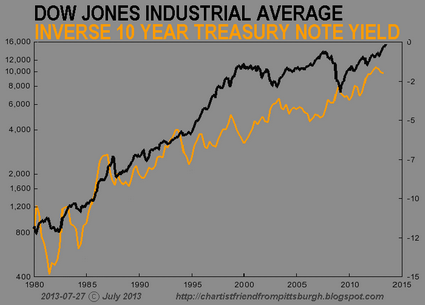What Is Going To Happen If Interest Rates Continue To Rise Rapidly?
 If
you want to track how close we are to the next financial collapse,
there is one number that you need to be watching above all others. The
number that I am talking about is the yield on 10 year U.S. Treasuries,
because it affects thousands of other interest rates in our financial
system. When the yield on 10 year U.S. Treasuries goes up, that is bad
for the U.S. economy because it pushes long-term interest rates up.
When interest rates rise, it constricts the flow of credit, and a
healthy flow of credit is absolutely essential to the debt-based system
that we live in. Just imagine someone squeezing a tube that has water
flowing through it. The higher interest rates go, the more economic
activity will be squeezed. If interest rates continue to rise rapidly,
it will be more expensive for the U.S. government to borrow money, it
will be more expensive for state and local governments to borrow money,
the housing market may crash again, consumer debt will become more
expensive, junk bond investors will be in for a world of hurt, the stock
market will experience a tremendous amount of pain and there is a good
chance that we could see the 441 trillion dollar interest rate derivatives bubble implode. And that is just for starters.
If
you want to track how close we are to the next financial collapse,
there is one number that you need to be watching above all others. The
number that I am talking about is the yield on 10 year U.S. Treasuries,
because it affects thousands of other interest rates in our financial
system. When the yield on 10 year U.S. Treasuries goes up, that is bad
for the U.S. economy because it pushes long-term interest rates up.
When interest rates rise, it constricts the flow of credit, and a
healthy flow of credit is absolutely essential to the debt-based system
that we live in. Just imagine someone squeezing a tube that has water
flowing through it. The higher interest rates go, the more economic
activity will be squeezed. If interest rates continue to rise rapidly,
it will be more expensive for the U.S. government to borrow money, it
will be more expensive for state and local governments to borrow money,
the housing market may crash again, consumer debt will become more
expensive, junk bond investors will be in for a world of hurt, the stock
market will experience a tremendous amount of pain and there is a good
chance that we could see the 441 trillion dollar interest rate derivatives bubble implode. And that is just for starters.So yes, we all need to be carefully watching the yield on 10 year U.S. Treasuries. On Friday, it opened at 2.76% and hit a high of 2.86% before closing at 2.83%. The yield on 10 year U.S. Treasuries is up nearly 120 basis points since the beginning of May, and almost everyone on Wall Street seems convinced that it is going to go much higher.
We are truly moving into unprecedented territory, because we have been in a bull market for U.S. Treasuries for the last 30 years. Many investors don't even know that it is possible to lose money on U.S. Treasuries. They have been described as "risk-free" investments, but that is far from the truth.
In fact, we could see bond investors of all types end up losing trillions of dollars before it is all said and done.
And those in the stock market will lose lots of money too. Low interest rates are good for economic activity which is good for the stock market. The chart posted below was created by Chartist Friend from Pittsburgh, and it shows that stock prices have generally risen as the yield on 10 year U.S. Treasuries has steadily declined over the past 30 years...

When interest rates rise, that is bad for economic activity and bad for stocks. That is why so many stock analysts are alarmed that interest rates are going up so rapidly right now.
And as I wrote about the other day, we have just witnessed the largest cluster of Hindenburg Omens that we have seen since before the last financial crisis. The stock market already seems ripe for a huge "adjustment", and rising interest rates could give it a huge extra push in a negative direction.
By the time it is all said and done, stock market investors could end up losing trillions of dollars in the next stock market crash.
In addition, rising interest rates could easily precipitate another housing crash. As the Wall Street Journal discussed on Friday, as the yield on 10 year U.S. Treasuries goes up it will also cause mortgage rates to rise...
Higher yields will push up long-term borrowing cost for U.S. consumers and businesses. Mortgage rates will rise, and investors are keeping a close eye on whether this may derail the recovery of the housing market, which has shown signs of turning a corner this year.In one of my previous articles, I included an example that shows just how powerful rising mortgage rates can be...
A year ago, the 30 year rate was sitting at 3.66 percent. The monthly payment on a 30 year, $300,000 mortgage at that rate would be $1374.07.If you own a $300,000 house today, do you think it will be easier to sell it or harder to sell it if mortgage rates skyrocket?
If the 30 year rate rises to 8 percent, the monthly payment on a 30 year, $300,000 mortgage at that rate would be $2201.29.
Does 8 percent sound crazy to you?
It shouldn't. 8 percent was considered to be normal back in the year 2000.
Yes, of course it will be much harder. In fact, there is a good chance that you will have to reduce your selling price significantly so that prospective buyers can afford the payments.
Let us hope that the yield on 10 year U.S. Treasuries levels off for a while. If it says at this current level, the damage will probably not be too bad.
But if it crosses the 3 percent mark and keeps soaring, things could get messy pretty quickly. In fact, according to a Bank of America Merrill Lynch investor survey, the 3.5 percent mark is when the collapse of the bond market is likely to become "disorderly"...
Read More Here











No comments:
Post a Comment
Hello and thank you for visiting my blog. Please share your thoughts and leave a comment :)